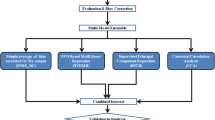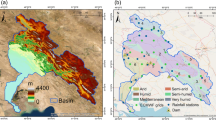Abstract
Winter precipitation occurs over North India due to the passage of a synoptic system originating from the Mediterranean known as western disturbances (WDs). Heavy rainfall, cold waves and fog are associated with WDs. Snowfall during winter over high-altitude regions of the Himalayas is vital for maintaining glaciers and Himalayan rivers, thus acting as a lifeline for billions of people living on the planes. Any predictive information about rainfall well in advance helps farmers fight drought situations, and forecasts of extreme events help save lives and property. In the present study, the multi-model ensemble based extended range forecast of winter rainfall over North India during the 2020–21 winter season is analyzed using the outputs of the National Centre for Environmental Prediction Climate Forecast System version 2 coupled model. The real-time forecast during the 2020–21 winter and hindcast during the 2003–2019 period are analyzed in this study. The study evaluates the deterministic and probabilistic skill of the extended range prediction system (EPS) in forecasting winter rainfall over North India on a weekly lead time scale and confirms the accuracy and usefulness of EPS from an operational point of view. EPS is skilful in predicting winter rainfall up to three weeks lead time in advance with low bias and low RMSE noted during the hindcast period. Positive anomaly correlation coefficients are observed in all lead time forecasts. Negative departure in rainfall during the January–February months is adequately captured in week 1, week 2 and week 3 forecasts. Probabilistic forecasts are determined using the ROC curve. Potential predictability of EPS is calculated using signal-to-noise ratio for all lead time forecasts.











Similar content being viewed by others
Data availability
The IMD gridded rainfall data with a resolution of 0.25 degrees is publicly available at https://www.imdpune.gov.in/cmpg/Griddata/Rainfall_25_NetCDF.html. Requests for extended-range rainfall data can be made to IMD.
References
Abhilash S, Sahai AK, Borah N, Chattopadhyay R, Joseph S, Sharmila S, Kumar A (2014) Prediction and monitoring of monsoon intraseasonal oscillations over Indian monsoon region in an ensemble prediction system using CFSv2. Clim Dyn 42:2801–2815. https://doi.org/10.1007/s00382-013-2045-9
Archer DR, Fowler HJ (2004) Spatial and temporal variations in precipitation in the Upper Indus basin, global teleconnections and hydrological implications. Hydrol Earth Syst Sci. https://doi.org/10.5194/hess-8-47-2004
Bernstein L, Bosch P, Canziani O, Chen Z, Christ R, Riahi K (2008) IPCC, 2007: climate change 2007: synthesis report. IPCC, Geneva (ISBN 2-9169-122-4)
Brier GW, Allen RA (1951) Verification of weather forecasts. Compendium of Meteorology, American Meteorological Society, Bostonhttps://doi.org/10.1007/978-1-940033-70-9_68
Chai T, Draxler RR (2014) Root mean square error (RMSE) or mean absolute error (MAE). Geosci Model Dev Discuss. https://doi.org/10.5194/gmd-7-1247-2014
Chalise SR (2002) Management of water resources for poverty alleviation in the Hindu-Kush Himalayas. FRIEND 2002—regional hydrology: bridging the gap between research and practice 274:27–34
Das S (2005) Mountain weather forecasting using MM5 modelling system. Curr Sci 88(6):899–905
Dimri AP (2004) Impact of horizontal model resolution and orography on the simulation of a western disturbance and its associated precipitation. Meteorol Appl 11:115–127. https://doi.org/10.1017/S1350482704001227
Dimri AP (2013) Intraseasonal oscillation associated with the Indian winter monsoon. J Geophys Res Atmos 118:1189–1198. https://doi.org/10.1002/jgrd.50144
Dimri AP, Chevuturi A (2014) Model sensitivity analysis study for western disturbances over the Himalayas. Meteorol Atmos Phys 123:155–180. https://doi.org/10.1007/s00703-013-0302-4
Dimri AP, Mohanty UC (1999) Snowfall statistics of some SASE field stations in J&K. Def Sci J 49:437. https://doi.org/10.14429/dsj.49.3858
Dimri AP, Niyogi D, Barros AP, Ridley J, Mohanty UC, Yasunari T, Sikka DR (2015) Western disturbances: a review. Rev Geophys 53:225–246. https://doi.org/10.1002/2014RG000460
Ek MB, Mitchell KE, Lin Y, Rogers E, Grunmann P, Koren V, Gayno G, Tarpley JD (2003) Implementation of Noah land surface model advances in the National Centers for Environmental Prediction operational mesoscale Eta model. J Geophys Res Atmos. https://doi.org/10.1029/2002JD003296
Graham RJ, Evans AD, Mylne KR, Harrison MS, Robertson KB (2000) An assessment of seasonal predictability using atmospheric general circulation models. Q J R Meteorol Soc 126:2211–2240. https://doi.org/10.1002/qj.49712656712
Griffies SM, Gnanadesikan AW, Dixon KW, Dunne JP, Gerdes R, Harrison MJ, Rosati A, Russell JL, Samuels BL, Spelman MJ, Winton M (2005) Formulation of an ocean model for global climate simulations. Ocean Sci 1(1):45–79. https://doi.org/10.5194/os-1-45-2005
Harvey LO Jr, Hammond KR, Lusk CM, Mross EF (1992) The application of signal detection theory to weather forecasting behavior. Mon Weather Rev 120:863–883. https://doi.org/10.1175/1520-0493(1992)120%3c0863:TAOSDT%3e2.0.CO;2
Kar SC, Rana S (2014) Interannual variability of winter precipitation over north-west India and adjoining region: impact of global forcings. Theor Appl Climatol 116:609–623. https://doi.org/10.1007/s00704-013-0968-z
Kulkarni A, Patwardhan S, Kumar KK, Ashok K, Krishnan R (2013) Projected climate change in the Hindu Kush-Himalayan region using the high-resolution regional climate model PRECIS. Mt Res Dev 33:142–151. https://doi.org/10.1659/MRD-JOURNAL-D-11-00131.1
Kumar N, Yadav BP, Gahlot S, Singh M (2015) Winter frequency of western disturbances and precipitation indices over Himachal Pradesh, India: 1977–2007. Atmósfera 28:63–70. https://doi.org/10.1016/S0187-6236(15)72160-0
Maharana P, Dimri AP (2014) Study of seasonal climatology and interannual variability over India and its subregions using a regional climate model (RegCM3). J Earth Syst Sci 123:1147–1169. https://doi.org/10.1007/s12040-014-0447-7
Mason I (1982) A model for assessment of weather forecasts. Aust Meteorol Mag 30:291–303
Mason SJ, Graham NE (2002) Areas beneath the relative operating characteristics (ROC) and relative operating levels (ROL) curves: statistical significance and interpretation. Q J R Meteorol Soc A 128:2145–2166. https://doi.org/10.1256/003590002320603584
Ménégoz M, Gallée H, Jacobi HW (2013) Precipitation and snow cover in the Himalaya: from reanalysis to regional climate simulations. Hydrol Earth Syst Sci 17:3921–3936. https://doi.org/10.5194/hess-17-3921-2013
Midhuna TM, Dimri AP (2020) Future projection of winter precipitation over north-west India and associated regions using CORDEX-SA experiments. Theor Appl Climatol 139(3):1317–1331
Mitra AK, Bohra AK, Rajeevan MN, Krishnamurti TN (2009) Daily Indian precipitation analysis formed from a merge of rain-gauge data with the TRMM TMPA satellite-derived rainfall estimates. J Meteorol Soc Jpn Ser II 87:265–279
Mooley DA (1957) The role of western disturbances in the production of weather over India during different Pisharoty seasons. Indian J Meteorol Geophys 8:253–260
Nageswararao MM, Mohanty UC, Osuri KK, Ramakrishna SSVS (2016) Prediction of winter precipitation over north-west India using ocean heat fluxes. Clim Dyn 47(7):2253–2271. https://doi.org/10.1007/s00382-015-2962-x
Pai DS, Rajeevan M, Sreejith OP, Mukhopadhyay B, Satbha NS (2014) Development of a new high spatial resolution (0.25 × 0.25) long period (1901–2010) daily gridded rainfall data set over India and its comparison with existing data sets over the region. Mausam 65(1):1–8. https://doi.org/10.54302/mausam.v65i1.851
Patil R, Kumar PP (2016) WRF model sensitivity for simulating intense western disturbances over North West India. Model Earth Syst Environ 2:82. https://doi.org/10.1007/s40808-016-0137-3
Pattanaik DR (2014) Meteorological subdivisional-level extended range forecast over India during southwest monsoon 2012. Meteorol Atmos Phys 124:167–182. https://doi.org/10.1007/s00703-014-0308-6
Pattanaik DR, Sahai AK, Mandal R, Muralikrishna RP, Dey A, Chattopadhyay R, Joseph S, Tiwari AD, Mishra V (2019) Evolution of operational extended range forecast system of IMD: prospects of its applications in different sectors. Mausam 70:233–264
Pattanaik DR, Sahai AK, Muralikrishna RP, Mandal R, Dey A (2020) Active-break transitions of monsoons over India as predicted by coupled model ensembles. Pure Appl Geophys 177:4391–4422. https://doi.org/10.1007/s00024-020-02503-2
Pisharoty PR, Desai BN (1956) Western disturbances and Indian weather. Indian J Meteorol Geophys 8:333–338
Prakash S, Sathiyamoorthy V, Mahesh C, Gairola RM (2014) An evaluation of high resolution multi satellite rainfall products over the Indian monsoon region. Int J Remote Sens 35:3018–3035. https://doi.org/10.1080/01431161.2014.894661
Rakesh V, Singh R, Yuliya D, Pal PK, Joshi PC (2009) Impact of variational assimilation of MODIS thermodynamic profiles in the simulation of western disturbance. Int J Remote Sens 30:4867–4887. https://doi.org/10.1080/01431160902980332
Rao YP, Srinivasan V (1969) Discussion of typical synoptic weather situation: winter western disturbances and their associated features. Indian Meteorological Department: Forecasting Manual Part III
Saha SK, Pokhrel S, Salunke K, Dhakate A, Chaudhari HS, Rahaman H, Sikka DR (2016) Potential predictability of Indian summer monsoon rainfall in NCEP CFSv2. J Adv Model Earth Syst 8:96–120. https://doi.org/10.1002/2015MS000542
Sahai AK, Chattopadhyay R, Goswami BN (2008) A SST based large multi-model ensemble forecasting system for Indian summer monsoon rainfall. Geophys Res Lett. https://doi.org/10.1029/2008GL035461
Semwal G, Dimri AP (2012) Impact of initial and boundary conditions on simulations of western disturbances and associated precipitation. Nat Hazards 64:1405–1424. https://doi.org/10.1007/s11069-012-0304-4
Shekhar MS, Kumar MS, Joshi P, Ganju A (2014) Mountain weather research and forecasting over western and central Himalaya by using mesoscale models. Int J Earth Atmos Sci 1(2):71–84
Shekhar MS, Rao NN, Paul S, Bhan SC, Singh GP, Singh A (2017) Winter precipitation climatology over Western Himalaya: altitude and Range wise study. J Ind Geophys Union 21:148–152
Shukla J, Gutzler DS (1983) Interannual variability and predictability of 500 mb geopotential heights over the northern hemisphere. Mon Weather Rev 111:1273–1279
Simmons AJ (1986) Numerical prediction: some results from operational forecasting at ECMWF. Adv Geophys 29:305–338
Thomas L, Dash SK, Mohanty UC (2014) Influence of various land surface parameterization schemes on the simulation of western disturbances. Meteorol Appl 21:635–643. https://doi.org/10.1002/met.1386
Tiwari PR, Kar SC, Mohanty UC, Kumari S, Sinha P, Nair A, Dey S (2014) Skill of precipitation prediction with GCMs over north India during winter season. Int J Climatol 34(12):3440–3455. https://doi.org/10.1002/joc.3921
Tiwari PR, Kar SC, Mohanty UC, Dey S, Sinha P, Raju PVS, Shekhar MS (2016) On the dynamical downscaling and bias correction of seasonal-scale winter precipitation predictions over North India. Q J R Meteorol Soc 142(699):2398–2410. https://doi.org/10.1002/qj.2832
Tiwari PR, Kar SC, Mohanty UC, Dey S, Sinha P, Shekhar MS (2017) Sensitivity of the Himalayan orography representation in simulation of winter precipitation using Regional Climate Model (RegCM) nested in a GCM. Clim Dyn 49(11):4157–4170. https://doi.org/10.1007/s00382-017-3567-3
Tiwari PR, Kar SC, Mohanty UC, Dey S, Sinha P, Shekhar MS, Sokhi RS (2019) Comparison of statistical and dynamical downscaling methods for seasonal-scale winter precipitation predictions over north India. Int J Climatol 39(3):1504–1516. https://doi.org/10.1002/joc.5897
Van den Dool H, Becker E, Chen LC, Zhang Q (2017) The probability anomaly correlation and calibration of probabilistic forecasts. Weather Forecast 32:199–206. https://doi.org/10.1175/WAF-D-16-0115.1
Wandishin MS, Mullen SL, Stensrud DJ, Brooks HE (2001) Evaluation of a short-range multi-model ensemble system. Mon Weather Rev 129:729–747. https://doi.org/10.1175/1520-0493(2001)129%3c0729:EOASRM%3e2.0.CO;2
Yadav RK, Kumar KR, Rajeevan M (2012) Characteristic features of winter precipitation and its variability over north-west India. J Earth Syst Sci 121:611–623
Zhu S, Wang Z, Heshka S, Heo M, Faith MS, Heymsfield SB (2002) Waist circumference and obesity-associated risk factors among whites in the third National Health and Nutrition Examination Survey: clinical action thresholds. Am J Clin Nutr 76(4):743. https://doi.org/10.1093/ajcn/76.4.743
Acknowledgements
India Meteorological Department (IMD) is fully funded by the Ministry of Earth Sciences (MOES), Government of India, New Delhi. Special thanks to Reba Mary Raju and Sebin John for their help in creating shapefiles. Authors are thankful to India Meteorological Department for providing IMD-GPM data.
Author information
Authors and Affiliations
Corresponding author
Additional information
Responsible Editor: Clemens Simmer, Ph.D.
Publisher's Note
Springer Nature remains neutral with regard to jurisdictional claims in published maps and institutional affiliations.
Supplementary Information
Below is the link to the electronic supplementary material.
Rights and permissions
Springer Nature or its licensor (e.g. a society or other partner) holds exclusive rights to this article under a publishing agreement with the author(s) or other rightsholder(s); author self-archiving of the accepted manuscript version of this article is solely governed by the terms of such publishing agreement and applicable law.
About this article
Cite this article
Thayyil Mandodi, M., Pattanaik, D.R. Predictive skill of extended range forecast of 2020–21 winter precipitation over North India. Meteorol Atmos Phys 135, 26 (2023). https://doi.org/10.1007/s00703-023-00965-2
Received:
Accepted:
Published:
DOI: https://doi.org/10.1007/s00703-023-00965-2




